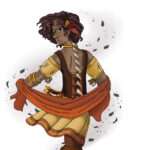Tail Difference
If your ancestry usually has a tail, yours is missing (IE 1) or (IE) times as long as is typical for someone of your height and ancestry. If your ancestry does not usually have a tail, you have one with a length of 50 + (IE) × 20% of your height. The tail is not prehensile but does help you balance, giving you a +(IE) bonus to balance-related Dexterity checks and saving throws. This gives you +(IE) to Dexterity (Sleight of Hand) checks but −(IE) to Charisma (Persuasion) checks with people who don’t know you due to many people’s discomfort around those with unexpected appearances, and some may mistake you for a lycanthrope or other shapeshifter.
Real-world Examples
This is a fantasy trait with no real-world analog.
Assistive Options
Loose-fitting clothing may allow you to hide the tail from casual observation.
Magical Assistance
A Seeming spell or similar magical effect is necessary to hide the tail.

